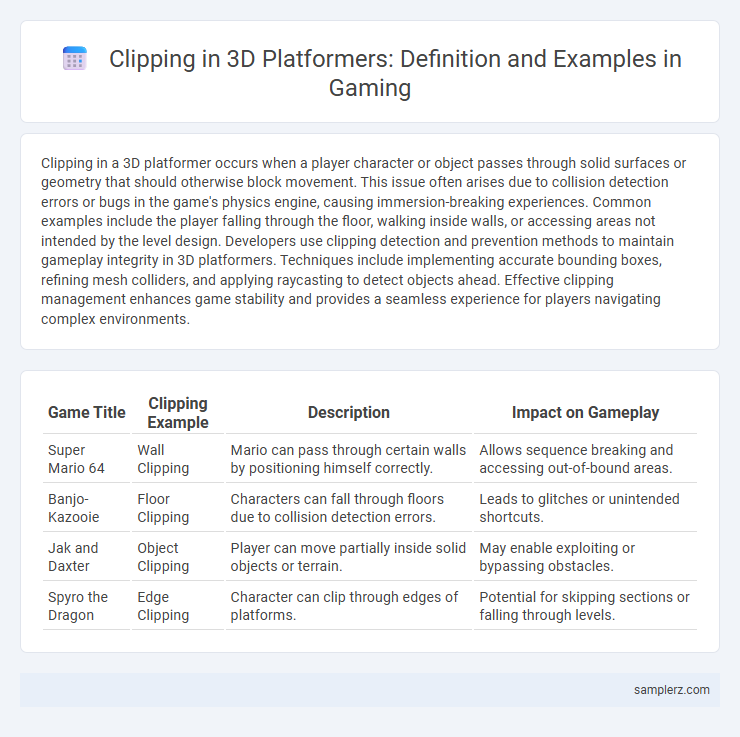Clipping in a 3D platformer occurs when a player character or object passes through solid surfaces or geometry that should otherwise block movement. This issue often arises due to collision detection errors or bugs in the game's physics engine, causing immersion-breaking experiences. Common examples include the player falling through the floor, walking inside walls, or accessing areas not intended by the level design. Developers use clipping detection and prevention methods to maintain gameplay integrity in 3D platformers. Techniques include implementing accurate bounding boxes, refining mesh colliders, and applying raycasting to detect objects ahead. Effective clipping management enhances game stability and provides a seamless experience for players navigating complex environments.
Table of Comparison
| Game Title | Clipping Example | Description | Impact on Gameplay |
|---|---|---|---|
| Super Mario 64 | Wall Clipping | Mario can pass through certain walls by positioning himself correctly. | Allows sequence breaking and accessing out-of-bound areas. |
| Banjo-Kazooie | Floor Clipping | Characters can fall through floors due to collision detection errors. | Leads to glitches or unintended shortcuts. |
| Jak and Daxter | Object Clipping | Player can move partially inside solid objects or terrain. | May enable exploiting or bypassing obstacles. |
| Spyro the Dragon | Edge Clipping | Character can clip through edges of platforms. | Potential for skipping sections or falling through levels. |
Understanding Clipping in 3D Platformers
Clipping in 3D platformers occurs when a character or object passes through solid geometry due to collision detection failures, such as walking through walls or floors. This issue often arises from bounding box inaccuracies or insufficiently defined collision meshes that fail to align with the visible environment. Effective solutions include refining collision boundaries and implementing raycasting techniques to enhance player-environment interactions and prevent immersion-breaking glitches.
Classic Clipping Glitches in Popular 3D Games
Classic clipping glitches in popular 3D platformers like Super Mario 64 and Banjo-Kazooie occur when characters pass through walls, floors, or other solid objects due to collision detection errors. These glitches are often exploited by speedrunners to access out-of-bound areas or skip large sections of the game. Leveraging polygon boundary oversights, classic clipping remains a prominent example of unintended but iconic gameplay mechanics in early 3D gaming.
How Players Exploit Clipping in Speedruns
Players exploit clipping in 3D platformers during speedruns by maneuvering their characters through solid objects or walls to skip entire sections or access out-of-bounds areas. Techniques such as frame-perfect jumps, precise camera angles, and collision detection manipulation allow speedrunners to bypass intended level geometry and save significant time. Popular titles like Super Mario 64 showcase advanced clipping strategies that have become essential in competitive speedrunning communities.
Famous Clipping Locations in Platformer Levels
Famous clipping locations in 3D platformers include the hidden wall in Super Mario 64's Hazy Maze Cave, where players exploit geometry to skip sections, and the boundary in Banjo-Kazooie's Treasure Trove Cove, allowing access to out-of-bounds areas. Another key example is Sonic Adventure's Mystic Ruins, where clipping through certain textures opens shortcuts that bypass large parts of the stage. These exploits highlight how developers' level designs can unintentionally create strategic advantages for speedrunners and casual explorers alike.
The Impact of Clipping Bugs on Gameplay Experience
Clipping bugs in 3D platformers, such as Mario passing through solid walls or falling through floors in Super Mario 64, disrupt the intended gameplay flow and challenge player immersion. These glitches often lead to unintended shortcuts or game-breaking exploits, undermining level design and difficulty balance. Persistent clipping issues frustrate players by breaking the spatial logic crucial for navigation and puzzle-solving in immersive 3D environments.
Developer Strategies to Prevent Clipping
Developers employ collision detection algorithms and boundary constraints to prevent clipping in 3D platformers, ensuring characters cannot pass through walls or floors. Utilizing mesh optimization and invisible barriers strategically placed within level design helps maintain immersion and gameplay integrity. Techniques such as dynamic physics adjustments and continuous environment testing further reduce the chances of graphical clipping bugs.
Unintended Shortcuts from Clipping Exploits
Unintended shortcuts in 3D platformers often arise from clipping exploits where players pass through walls, floors, or objects that were not meant to be traversed. These exploits break level boundaries, allowing bypass of intended challenges and sequence breaks that speedrunners frequently utilize. Games like Super Mario 64 and Banjo-Kazooie highlight how clipping through geometry can dramatically alter gameplay strategies by enabling early access to later areas.
Comparing Clipping Issues Across Different 3D Platformers
Clipping issues in 3D platformers manifest differently depending on the game engine and level design complexity, with titles like Super Mario 64 often exhibiting minor edge clipping due to simpler geometry, while more graphically advanced games like Ratchet & Clank show deeper clipping problems around environmental objects and character models. Comparing games such as Crash Bandicoot and Spyro the Dragon highlights how varying collision detection algorithms impact player experience, where Crash Bandicoot's tight clipping zones restrict movement precision more than Spyro's smoother boundary handling. Developers optimize clipping detection by balancing polygon count, camera control, and collision mesh accuracy to minimize immersion-breaking glitches across varying platformer environments.
User-Discovered Clipping Tricks and Community Reactions
User-discovered clipping tricks in 3D platformers often involve exploiting unintended geometry interactions to bypass obstacles or access hidden areas, such as clipping through walls or floors using precise character positioning. Popular examples include skipping large portions of levels in titles like "Super Mario 64" or "Banjo-Kazooie," which speedrunners widely share and refine. The gaming community reacts with excitement and creativity, turning these glitches into skillful techniques that redefine gameplay strategies and foster collaborative discovery.
Notable Clipping Instances in Platformer History
Notable clipping instances in 3D platformer history include the "Super Mario 64" wall-clip, where players exploit geometry to access out-of-bounds areas early. Another famous example is in "Banjo-Kazooie," where intentional clipping spots allowed sequence breakers and hidden item access. These instances highlight how clipping techniques have evolved from glitches to advanced gameplay strategies within platformer communities.

example of clipping in 3D platformer Infographic
 samplerz.com
samplerz.com